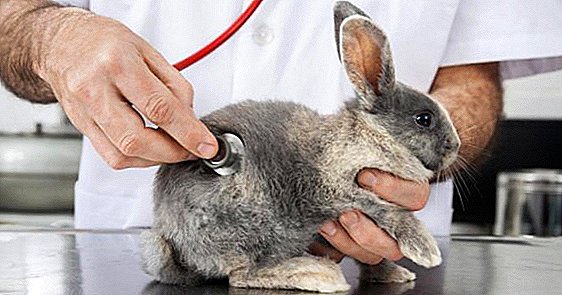 When our pets get sick, we try in every way to help them and cure their illness. But before rendering first aid to a sick person, it must be remembered that infectious animal diseases can be infectious for humans. And this means that you must first take care of your safety, because the health of your pet depends on your health. And in this article we will consider those diseases of rabbits that are dangerous to humans.
When our pets get sick, we try in every way to help them and cure their illness. But before rendering first aid to a sick person, it must be remembered that infectious animal diseases can be infectious for humans. And this means that you must first take care of your safety, because the health of your pet depends on your health. And in this article we will consider those diseases of rabbits that are dangerous to humans.
Obvious signs of a sick rabbit
Despite the fact that rabbits are valuable animals in every sense (their meat is rich in various vitamins, macro and microelements; their fur is considered valuable for the manufacture of outerwear, hats and boots), nature has endowed them with fragile and susceptible organisms that are often not capable of independently suppress the source of infection.  Unfortunately, not every disease can be defined "by eye", because the symptoms of infection may not manifest until such time as it is not too late. Rabbits can continue an active lifestyle, eat well and show all signs of a healthy and full-fledged animal, but at one moment, when the incubation process of the development of a viral infection stops, these little fluffs burn out before their eyes, parting with life.
Unfortunately, not every disease can be defined "by eye", because the symptoms of infection may not manifest until such time as it is not too late. Rabbits can continue an active lifestyle, eat well and show all signs of a healthy and full-fledged animal, but at one moment, when the incubation process of the development of a viral infection stops, these little fluffs burn out before their eyes, parting with life.
Important! To In time to recognize the first symptoms of infection, all individuals from the rabbit herd should be regularly examined. Adults - once a week, and babies who have not reached 1 month of birth, should be inspected every day, because rabbits are most susceptible to infectious diseases due to a weak immune system. Also, be sure to inspect the males and females before mating, and the female still before and after caul.
In the power of the rabbit breeder to recognize some signs that will indicate that the individual in front of him fell ill.
These signs look like this:
- sluggish appearance of the animal, often in a supine position;
- unusual behavior patterns;
- serous or clear discharge from the mucous membranes;
- shedding of hair, partial or complete baldness, loss of shine in wool;
- difficult and rapid breathing;
- bouts of tremor;
- ulcerative or purulent formations on the body;
- the presence of blood in the stool, frequent and profuse diarrhea or, conversely, constipation;
- manifestation of convulsions and paralysis;
- lice or flea attack.

What diseases of rabbits are dangerous to humans?
The list of the most common viral and infectious lesions of rabbit herds, which present a fairly high degree of danger to human health, includes: scabies, fascioliasis, cysticercosis, pasteurellosis, listeriosis, helminthiasis, tularemia and several others. Consider them in more detail.
Did you know? The record length of the rabbit's ears was officially registered at 80 centimeters.
Scabies (psoroptosis)
Scabies is a disease of the skin of the rabbit, which is a danger to humans. Pathogen: transmitted along with the tick. Skin mites cause itching and irritation. The favorite places for tick placement are the auricle or the scalp, under the scalp.
Symptoms: the presence of small redness on the skin, in the center of which the wound is visible. Light swellings are also possible in this area, the appearance of small transparent bubbles with a liquid substance inside, which results in the explosion of a thin shell, after which it dries out and creates scabs. 
Treatment: dried scabs should be moistened with turpentine and removed using tweezers. After 4-5 days, this procedure is recommended to be repeated.
Prevention: As an additional protection against ticks, it is recommended to treat the cage with rabbits with a 5% Creolin solution.
We advise you to get acquainted with different breeds of rabbits: white giant, gray giant, Californian, Angora, black-brown, butterfly, French ram, flandr, Soviet chinchilla.
Fascioliasis
Fascioliasis - rabbit helminthic disease affecting the liver and biliary system, can occur in an acute or chronic form.
Pathogen: the mollusk is a small pond fish, which is found in standing bodies of water, such as lakes or ponds, as well as in the grass growing near water bodies.
Symptoms:
- rapid pulse;
- confused, uneven breathing;
- stiff eyelids;
- heat;
- puffiness in the abdomen and neck.

Treatment: Using a probe, 1-2 ml of carbon tetrachloride is injected into the body of the rabbit, and this treatment is combined with the anthelmintic drugs Bitinol and Closantel.
Prevention: in order to prevent infection, grass collected near water bodies should be eliminated from the diet of rabbits, and not watered with water from ponds and lakes.
Did you know? A rabbit weighing two kilograms can drink the same amount of water as a dog weighing ten kilograms.
Cysticercosis
Cysticercosis is an invasive disease caused by parasitizing the cestode larvae of dogs, foxes and cats in the muscle tissue. Quite widespread, it affects young rabbits at the age of 1 month. It is dangerous for humans who come into contact with an infected animal.
Pathogen: cestode larvae localized in the omentum, pelvic peritoneum protrusion and under the liver capsule. It can also spread to all organs inside the body of an animal.
Symptoms: has no specific signs of infection. The only symptom is depressed appearance and low mobility, but these same indicators also indicate many other diseases, and therefore you cannot determine the type of the disease without consulting a veterinarian. Unfortunately, it is extremely rare to correctly diagnose cysticercosis. Often this is only possible after opening the dead rabbit. 
Treatment: This disease is not treated.
Prevention: it is necessary to hold quarterly measures for deworming the livestock of rabbits, introducing 10% "Mebenvet granulate" into their food. Also, stray or guard dogs that may become a source of infection are not allowed near the rabbit. Dead rabbits need to be burned to prevent the spread of infection.
Did you know? Rabbits chew 120 times a minute and have more than 17,000 taste buds.
Pasterellosis (hemorrhagic septicemia)
Pasteurellosis is a particularly dangerous bacteriological lesion characterized by inflammation of the internal organs. A person has a high risk of infection by contact with a sick animal. There are two types of this disease: typical and atypical.
Pathogen: provocateur acts stick Pasteurella.
Symptoms: Among the characteristic signs of a typical form of pasteurellosis include:
- increased temperature followed by a rapid decrease;
- rabbit's reluctance to eat;
- increased and uneven respiratory processes;
- gray and turbid discharge from the mucous membranes on the face;
- often accompanied by profuse diarrhea.

Treatment: typical form cannot be cured. Rabbits die within 1-3 days. Atypical form is treated with antibiotics. Twice the introduction of the injection "Biomitsin" in a solution of 2% and a single injection of "Terramycin". All three injections are administered intramuscularly, observing an interval of 20 hours. Abscesses are opened for the third month from the moment of infection, pus flows out, and the remaining wounds heal. The affected areas can be cleaned with antiseptics to speed up the abscess breakthrough and wound healing.
Prevention: compliance with all rules of hygiene and sanitary conditions of animals. Conduct disinfecting procedures at least 1 time per month.
Did you know? According to legend, the representative of the Aztec Indian people, Mayaual, witnessed how the agave gorged like a drunk. and rushed around the field like crazy. Thanks to the discovery of the intoxicating properties of this cactus Mayaual became a goddess, a kind of personification of the agave. Later she gave birth to 400 rabbits, who were called patrons of intoxication. To this day in Mexico there is a scale of intoxication from 1 to 400 rabbits, and before drinking pulque, the Mexicans shed a little of this alcoholic drink on the floor, thus making a sacrifice to the rabbits.
Listeriosis
Infectious septic disease of rabbits, characterized by sudden death or abortion. It occurs in acute, super-acute and chronic forms.
Pathogen: Listeria is the same bacterium that causes the development of this disease.
Symptoms: most females are at risk of infection with this disease. In the super-acute form of listeriosis, females may die unexpectedly without any obvious reason for this. In acute form, the female is not able to bear offspring, and she has miscarriages. Immediately after a miscarriage, her limbs are taken away from her. In the chronic form, females cannot give offspring at all, since each time the embryo dies in the uterus even before maturation. Only some females with strong immunity can survive, the rest die. 
Treatment: today no treatment has been found. All infected individuals are subject to slaughter.
Prevention: carrying out regular cleaning of cages, trays, changing bedding and examining animals in accordance with the regulations.
We advise you to read about how to water the rabbits with water, what to not feed the rabbits with, what grass to feed the rabbits, what to eat and what to feed the rabbits in the winter.
Helminthiasis (worms)
Helminthiasis is a helminthic affection of an animal that is capable of being transmitted to humans by direct contact.
Pathogen: worms from the classes of trematodes, cestodes, nematodes (more than 10 species).
Symptoms: in infected rabbits, there is lethargy, weakness, inactivity, often a refusal to eat and even a rise in temperature. A careful examination of the feces can reveal white worms eggs or whole fragments of parasites. Often, worms are able to spread far beyond the intestine throughout the body of an animal, forming a whole cavity in the internal organs filled with larvae. 
Treatment: After conducting laboratory tests, the veterinarian will prescribe a complex of drugs that will contribute to the death and removal of worms from the body of the rabbit. Also favorable will be deworming at least once a quarter.
Prevention: sanitation, quality food and fresh water.
Tularemia
Tularemia is an infectious disease that affects the lymph nodes, most often striking at young individuals in the herd. It is also a danger to humans when in contact with infected individuals.
Pathogen: infection is carried out by air, by eating food and water, as well as by mosquito bites.
Important! If a rabbit recovers with tularemia and is cured, then this infection is no longer terrible for him, since his body develops immunity.Symptoms: often any symptoms during tularemia are absent. Only in the acute final stage do rabbits begin to breathe with shortness of breath and cough up. Also, they can shiver and fever, and even on their little bodies jump little pustules. If you start this disease, it can result in an increase in lymph nodes and paralysis. During pregnancy, females often have miscarriages.

Treatment: absent, and therefore special attention should be paid to preventive measures.
Prevention: observance of sanitary rules, carrying out measures for cleaning and disinfection of the rabbit, personal hygiene and the fight against mosquitoes, mice and rats.
Disease prevention
In order to minimize the likelihood of infection of rabbit herds of various kinds of viruses and infections, a number of preventive measures should be applied, and the following recommendations should be taken into account:
- ensuring air circulation, but without drafts;
- timeliness of cleaning and disinfection;
- bedding replacement at least once every three days;
- wash troughs and drinkers thoroughly, removing food residues so that bacteria do not grow in them;
- food and water should always be fresh and of high quality;
- Expose your pet regularly to routine screening for symptoms of infection.
- special attention during the inspection to give mucous membranes and the presence of serous discharge, because they are often the first signs of impending trouble.
In addition to the general rules of care and maintenance of rabbits, you should also conduct regular vaccination of pets. There are separate vaccinations for myxomatosis and UHD. But also modern veterinary medicine has developed complex drugs that can at once reduce the risk of the emergence and development of several of the most common and dangerous infections.
We recommend reading about how to determine the sex of a rabbit, how long it lasts and how to determine the sugary nature of a rabbit, whether it is possible to keep chickens and rabbits together, what affects life expectancy and how long the rabbits live on average, what to do during sun and heat stroke in rabbits.
A similar vaccination is recommended every year. Vaccination can be started from 1.5 months of age and, if necessary, and on the recommendation of the veterinarian, a second revaccination should be performed after 6-9 months.  We all know the phrase: "We are responsible for those who have tamed." But do not forget that their own health is also important. And before contacting an infected animal, you need to take all precautions to avoid catching the infection yourself. Guided by the descriptions in the article of the most dangerous and contagious diseases of rabbits for humans, you can protect yourself from accidental infection.
We all know the phrase: "We are responsible for those who have tamed." But do not forget that their own health is also important. And before contacting an infected animal, you need to take all precautions to avoid catching the infection yourself. Guided by the descriptions in the article of the most dangerous and contagious diseases of rabbits for humans, you can protect yourself from accidental infection.












